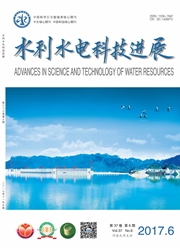

 中文摘要:
中文摘要:
针对小湾特高拱坝首次蓄水期坝体变形备受关注的几个焦点问题,运用综合过程线对比、数学建模、数值仿真、数理统计分析等定性和定量方法进行分析,结果表明:小湾大坝坝体蓄水早期向上游方向倾斜(主要与库盘下沉有关),库水位是首蓄期坝体变形的最主要影响因素,坝体时效变形已趋于收敛.通过将数值仿真成果与实测值比较、模型分析与实测值比较、设计预警指标与实测值比较、小湾工程与同类工程实测值比较,认为小湾水电站特高拱坝经受了正常蓄水位工况下的综合考验,尽管变形量值较大,但变形规律总体正常,首蓄期大坝处于安全状态.
 英文摘要:
英文摘要:
In consideration of some key problems relating to the deformation of the Xiaowan Arch Dam during the first impoundment, the deformation was analyzed with qualitative and quantitative methods, including comprehensive hydrograph analysis, model analysis, numerical simulation, and mathematical statistics. The results show that the dam inclined upstream in the early stage of reservoir impoundment, mainly due to the sinking of the reservoir basin. The reservoir water level was the main factor in the dam deformation, and the time-effect component of the deformation tended to be convergent during the first impoundment. Comparisons of numerical results, modeled results, and designed warning indexes with measured data from the Xiawen Arch Dam, as well comparisons of its measured data with those of other similar projects, demonstrate that the Xiaowan Arch Dam operated normally at the normal water storage level. Although the deformation was relatively large in this case, its regularity was reasonable, demonstrating that the dam was in a safe condition during the first impoundment.
 同期刊论文项目
同期刊论文项目
 同项目期刊论文
同项目期刊论文
 期刊信息
期刊信息
